Your Ultimate Content Marketer’s Guide to Keyword Research
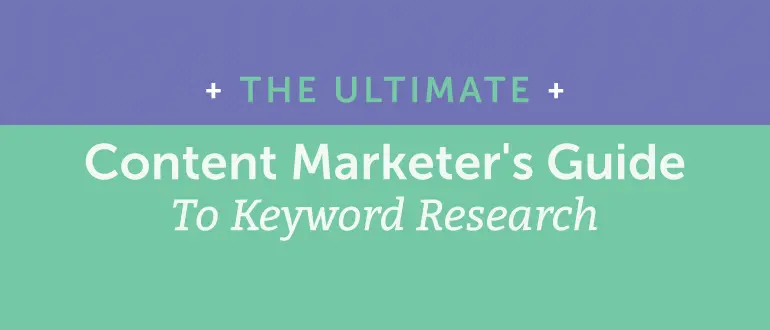 I am sure you've heard of the term "keyword research" before. Everyone is talking about it, yet it's often misunderstood.
Keyword research is the process of finding words and phrases that best represent what your site does. Keyword research is heavily based on searching behavior: We research keywords that people tend to type in the search box. The main goal of keyword research is to get your pages rank for keywords we optimize them for.
This guide will take you through the process of selecting, organizing and placing the keywords in order to help you brainstorm article ideas and create content that achieves higher search rankings.
Recommended: CoSchedule Keyword Generator
I am sure you've heard of the term "keyword research" before. Everyone is talking about it, yet it's often misunderstood.
Keyword research is the process of finding words and phrases that best represent what your site does. Keyword research is heavily based on searching behavior: We research keywords that people tend to type in the search box. The main goal of keyword research is to get your pages rank for keywords we optimize them for.
This guide will take you through the process of selecting, organizing and placing the keywords in order to help you brainstorm article ideas and create content that achieves higher search rankings.
Recommended: CoSchedule Keyword Generator
Is Keyword Research Dead (Or Dying)?
It's been in attention baiting headlines many times: Many of those claim both SEO and keyword research on deathbed and it's been nothing new for as long as SEO exists. The truth is, neither keyword research nor SEO are going anywhere. They are evolving and maturing, yes, but not dying for sure.Neither keyword research nor SEO are going anywhere.
Click To TweetGet Your Free Keyword Research Template Bundle
Do better keyword research with these three free downloadable resources:- A Keyword Research List Template to store your keyword ideas (and never lose them).
- A Latent Semantic Indexing infographic to better understand how infusing content with secondary keywords impacts SEO.
- An on-page SEO checklist to fully optimize each piece of content you create.
Your Ultimate Content Marketer's Guide to Keyword Research
Click To TweetKeyword Research: Where to Start
Keyword research starts with defining the core terms (or seed terms or head terms). These are the most essential terms that your industry revolves around. Further into keyword research your task will be to expand the list of your core terms with various keyword modifiers. That being said, you may come across slightly different ways to explain the keyword structure, but I prefer to stick to the most simple one. A keyword consists of:- Core term: Your most important word or phrase that defines your site. In the ideal world, you want to rank #1 for this term but too many sites share this desire.
- Keyword modifiers: Words that come with your core terms making up longer phrases that are usually easier to rank for (because not as many sites want to compete with you for those rankings).
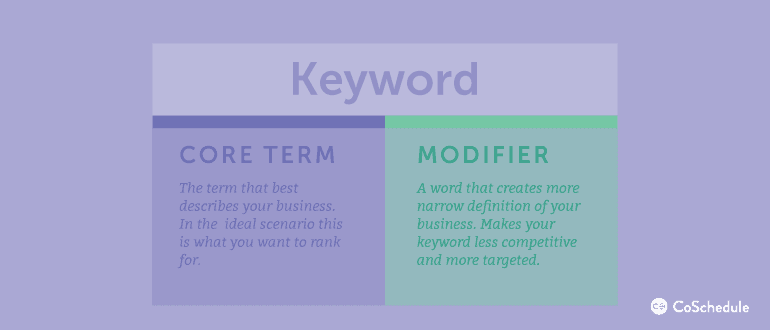 Your core term can be as broad and as generic as the nature of your business dictates. In most cases, you are the best (and maybe the only one) to tell which words define your business best.
Your core term can be as broad and as generic as the nature of your business dictates. In most cases, you are the best (and maybe the only one) to tell which words define your business best.
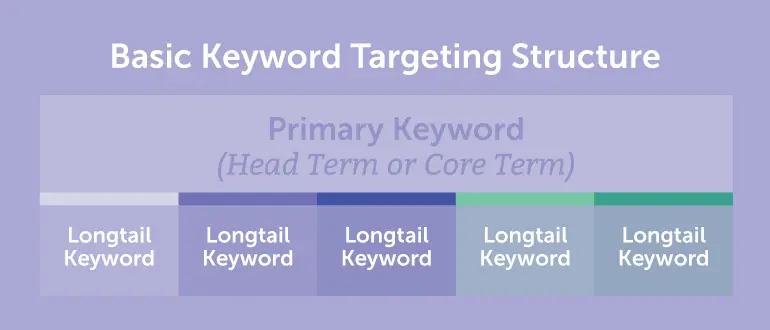 For example, if you are running a restaurant, your core term isn't really [restaurant] because you don't want to rank #1 when people simply type [restaurant]. The real word you want to rank for is whatever city you are in plus restaurant: That's what will drive customers your way.
So in this simplistic scenario, your core term is something like [Austin restaurant]. On top of that, your other core terms may be:
For example, if you are running a restaurant, your core term isn't really [restaurant] because you don't want to rank #1 when people simply type [restaurant]. The real word you want to rank for is whatever city you are in plus restaurant: That's what will drive customers your way.
So in this simplistic scenario, your core term is something like [Austin restaurant]. On top of that, your other core terms may be:
- [restaurants in Austin]
- [restaurant in Austin]
- [downtown Austin restaurants]
- [vegan restaurant in Austin]
- [Italian restaurant in Austin]
- [Best restaurants in Austin]
- [Top restaurants in Austin]
- [Best-rated restaurants in Austin], and so on
 The basic and traditional goal of keyword research is to expand your core term using all kinds of modifiers and assess which of those phrases will give you more chances to rank as high as top 5 Google search results.
So let's talk about distinguishing your core terms first.
The basic and traditional goal of keyword research is to expand your core term using all kinds of modifiers and assess which of those phrases will give you more chances to rank as high as top 5 Google search results.
So let's talk about distinguishing your core terms first.
So How to Find Those Core Terms?
Like I said, in most cases those will come from your common knowledge. If you've been in the industry at least for some time, you'll know which words flow around. However there are tools to help, of course. Google AdWords Keyword Planner Tool is perhaps the most useful one to start with. Type the first word that comes to mind and it will suggest more terms and phrases. For example, for [chocolate] top suggestions are:- dark chocolate
- chocolate truffles
- chocolate gifts
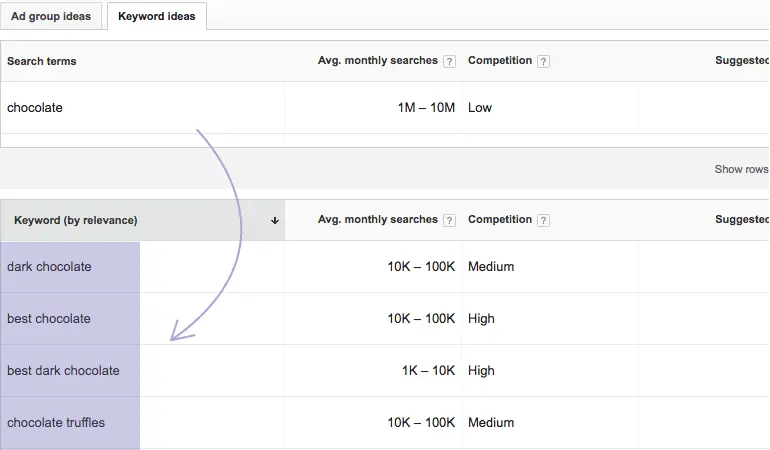 Another solid idea to start your keyword research with, especially if you are somewhat new to a niche, is to look for industry thesauruses and glossaries to go through most common terms and definitions. This will give you a few more ideas of core terms to start with. Even generic thesauruses will help. For example, Thesaurus.com is always a good start. Here are its suggestions for chocolate terms:
Another solid idea to start your keyword research with, especially if you are somewhat new to a niche, is to look for industry thesauruses and glossaries to go through most common terms and definitions. This will give you a few more ideas of core terms to start with. Even generic thesauruses will help. For example, Thesaurus.com is always a good start. Here are its suggestions for chocolate terms:
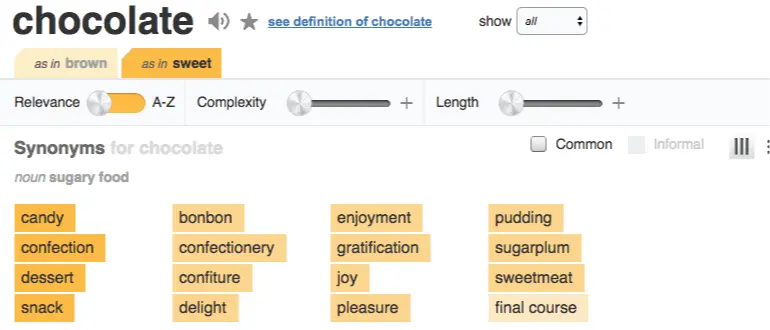 Searching Google for [chocolate terms] will give you lots of more words to play with. Here's what I found:
Searching Google for [chocolate terms] will give you lots of more words to play with. Here's what I found:
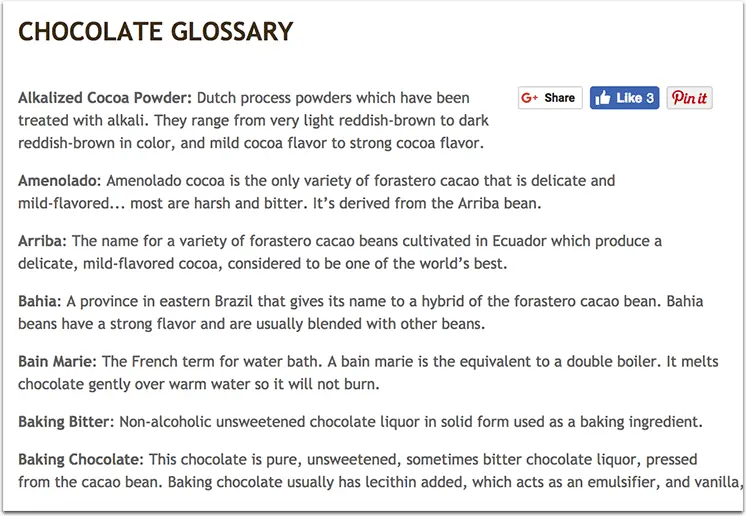
How to Find Valuable Keywords?
Simply expanding your list with longer phrases isn't enough. The actual goal is to find valuable keywords. Simply put, a valuable keyword is the one that has a high demand and a low competition. This means that enough people type this phrase in a search engine for you to go into trouble to create content for it while not too many publishers have already created content targeting that exact word for you to have a chance to rank high. As you can imagine, it's not really easy to find keywords like this because web publishers and marketers have been searching for them for many years now. Luckily, there are tools to help. I have explained a quick keyword research exercise here. In short, using the tool like Serpstat, you need to find keyword phrases with high search volume (i.e. high demand) and low competition (i.e. low offer) If chocolate is your major topic, here would be your lower-competition phrases that offer pretty exciting content ideas: Mind that any of the above can be expanded further: Just click any phrase and the tool will suggest even more ideas:
Mind that any of the above can be expanded further: Just click any phrase and the tool will suggest even more ideas:
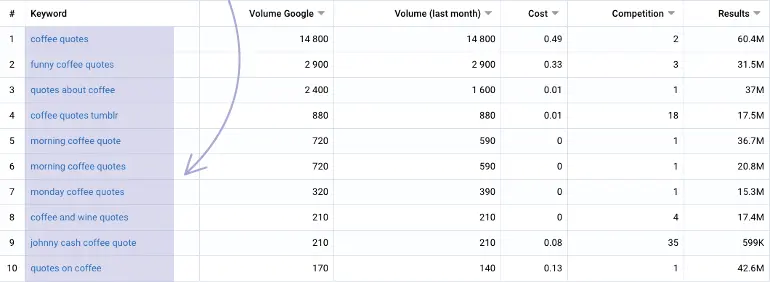 These are all great content ideas and you can estimate the demand (search volume) and offer (competition) at a glance too.
However, take the competition number with a grain of salt. It is based on the aforementioned Google AdWords Keyword Planner Tool competition metric, however it doesn't reflect the organic search competition: It shows how many advertisers want to pay to show their ads for that term, so it is not always the competition you are looking for.
For example, Google will label competition for the word [chocolate] as "low", however it's almost impossible to actually rank for that word in Google, because it's too common and too many powerful publishers already rank for it...
These are all great content ideas and you can estimate the demand (search volume) and offer (competition) at a glance too.
However, take the competition number with a grain of salt. It is based on the aforementioned Google AdWords Keyword Planner Tool competition metric, however it doesn't reflect the organic search competition: It shows how many advertisers want to pay to show their ads for that term, so it is not always the competition you are looking for.
For example, Google will label competition for the word [chocolate] as "low", however it's almost impossible to actually rank for that word in Google, because it's too common and too many powerful publishers already rank for it...

So How to Better Estimate Competition?
When you finally have the list of the keywords you want to base your content around, make sure you actually search Google and scroll through top 10 results. Here are a few flags I am using:- Are there articles ranking high or rather home pages? It will be harder to compete with home pages because they usually accumulate lots of positive signals. Home pages are the most powerful pages of pretty much any website.
- How many really huge websites rank on top? For example, Wikipedia links are almost impossible to outrank. But there are other huge publishers that dominate every other niche, like imbd.com, popsugar.com, buzzfeed.com and others. If top positions in search results are dominated by huge brands, that will be hard to beat.
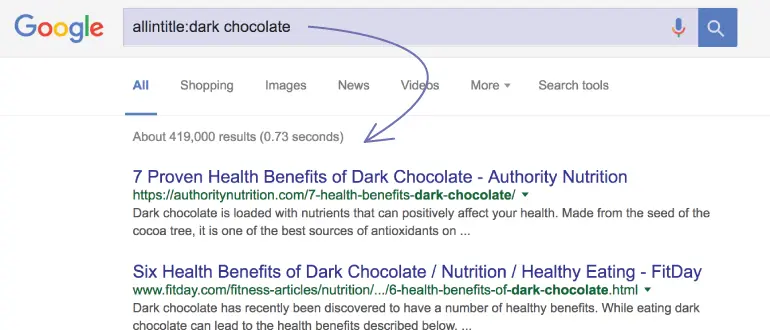 Another thing to always check in Google is the presence of blended results, i.e. other types of search results Google may show on top of their generic blue-and-white results. These can be:
Another thing to always check in Google is the presence of blended results, i.e. other types of search results Google may show on top of their generic blue-and-white results. These can be:
- Image search results,
- Shopping search results
- News search results.
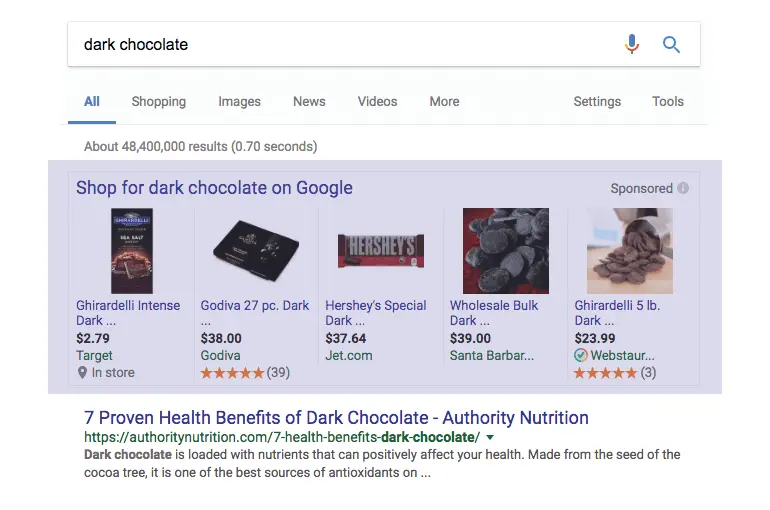 Serpstat shows whether these blended search results appear if you search for any keyword in their list:
Serpstat shows whether these blended search results appear if you search for any keyword in their list:
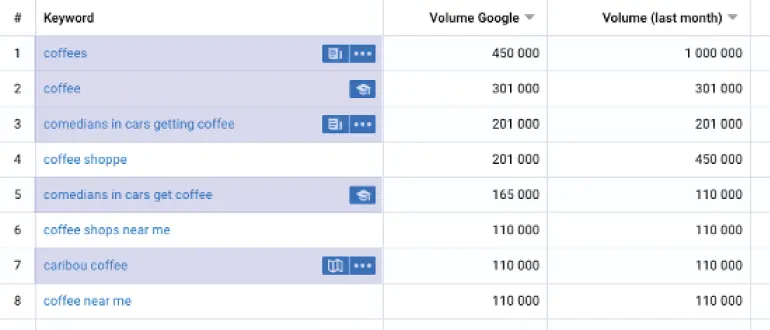 These may indicate that a particular keyword is not worth too much effort because there will be too much of something else all around search results for users to find your article:
These may indicate that a particular keyword is not worth too much effort because there will be too much of something else all around search results for users to find your article:
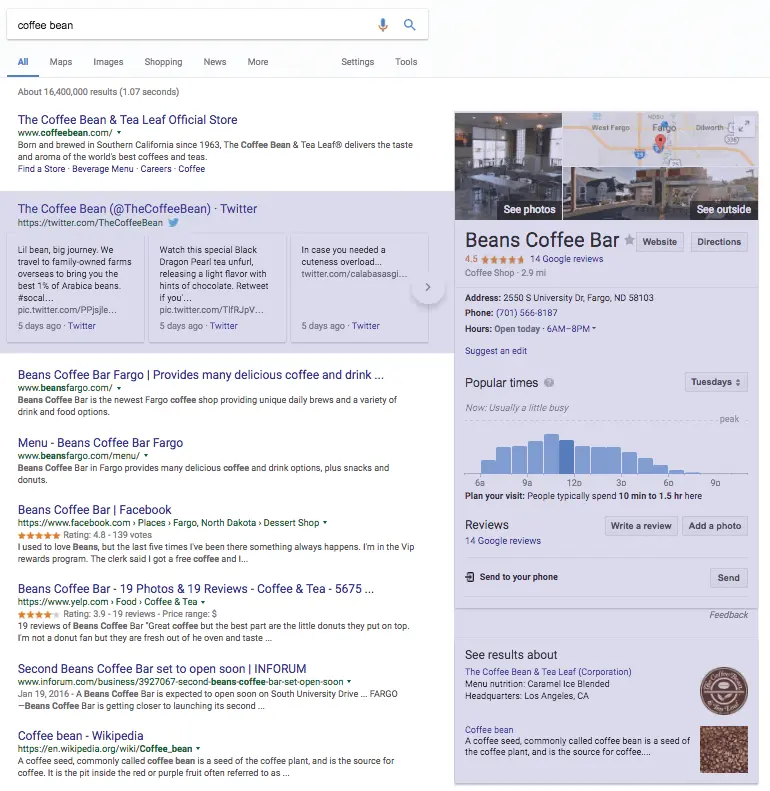
- Usually they appear for more popular (more competitive) terms
- They may signal of keyword intent which is something we'll talk more about next.
What Is Keyword Intent?
Keyword intent represents what the searcher may be willing to do when searching for a particular phrase. Keyword intent is the most important concept when it comes to keyword research. It determines how well you can satisfy the user who comes to your site from search results. There are three major types of keyword intent:- Informational: A user is looking to find answers to their questions. For example, [chocolate history] signals of informational intent.
- Trasactional: A user is looking to buy something. For example, when a user is searching for [personalized chocolate], they are most likely to buy some. Another example with the definitive transactional intent is [order chocolates online]
- Navigational: A user wants to find a specific brand, for example [hershey chocolate]
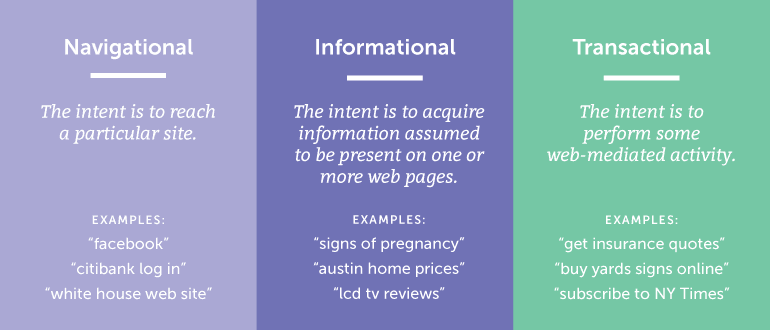 Content marketers also distinguish "commercial intent", that is when a user researches something before buying one.
Taking our chocolate example above, if a user searches for [chocolate gifts], they are most likely to be interested in buying some gifts but they may also be interested in reading your article listing most unique chocolate gift ideas together with suggestions where to find them.
Content marketers also distinguish "commercial intent", that is when a user researches something before buying one.
Taking our chocolate example above, if a user searches for [chocolate gifts], they are most likely to be interested in buying some gifts but they may also be interested in reading your article listing most unique chocolate gift ideas together with suggestions where to find them.
How to Organize Those Keywords?
So you go through lists and lists of keywords... how to make use of them to turn into a long-lasting content marketing plan? Here are a few ways to organize your keywords:Organize by Intent
The first step is to organize keywords by intent:- Keywords with informational intent. Those are outright content ideas to add to your content editorial calendar.
- Keywords with transactional intent. These are seldom content ideas. You'd better hand those off to your product development team.
- Keywords with commercial intent. Those are keywords that require some more brainstorming: You need to actually have the products in mind in order to create content around these keywords because your readers will ultimately be interested in making an action (i.e. buying).
- If you have a product to sell, think which type of content would be best to direct those visitors into your sales funnel. Maybe that could be a downloadable guide or a list article.
- If you monetize your site through ads and affiliate programs, think which ones would be good to list in content here.
- Keywords with navigational intent may become part of your reputation management strategy or competitive research.
Organize by Action
- Some keywords may be good ideas for future content
- Some keywords may be used to optimize or update old content
Organize by Content Type
Depending on your site, different keywords may become different content forms:- FAQ pages
- Blog posts
- Indepth articles (Maybe with pdf downloads available)
- On-site glossaries
- Product reviews
- Various types of cornerstone content
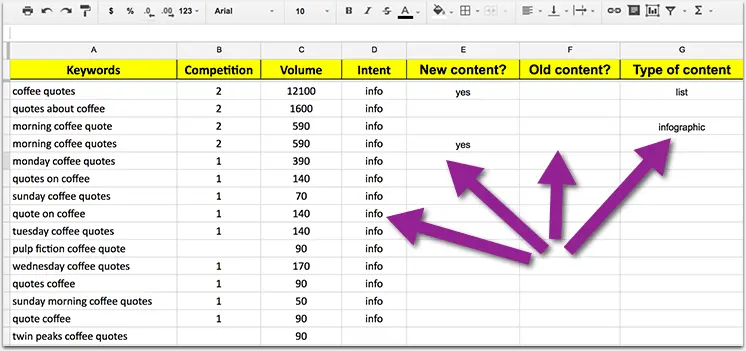
How Do Keywords Structure Your Content?
As I mentioned above, not all keywords will necessarily become a separate piece of content idea. Some of them will become subtopics of articles. When doing keyword research, I usually create "tree-like structure" for sets of phrases that would make separate articles. For example, if you decide to write an article on [coffee quotes], a separate article idea would be [morning coffee quotes].- monday coffee quotes
- sunday coffee quotes
- tuesday coffee quotes
- wednesday coffee quotes
- saturday coffee quotes
 You'll save lots of time writing future article creating these trees while still doing your keyword research. They will direct your writing helping you create more in-depth content.
These will also make up your article subheadings (those H2 or H3 headers you see in most articles here). If you get even geekier, you can generate the clickable table of contents using those subheadings. This way there will be even more visible instances of the keyword in the page:
You'll save lots of time writing future article creating these trees while still doing your keyword research. They will direct your writing helping you create more in-depth content.
These will also make up your article subheadings (those H2 or H3 headers you see in most articles here). If you get even geekier, you can generate the clickable table of contents using those subheadings. This way there will be even more visible instances of the keyword in the page:
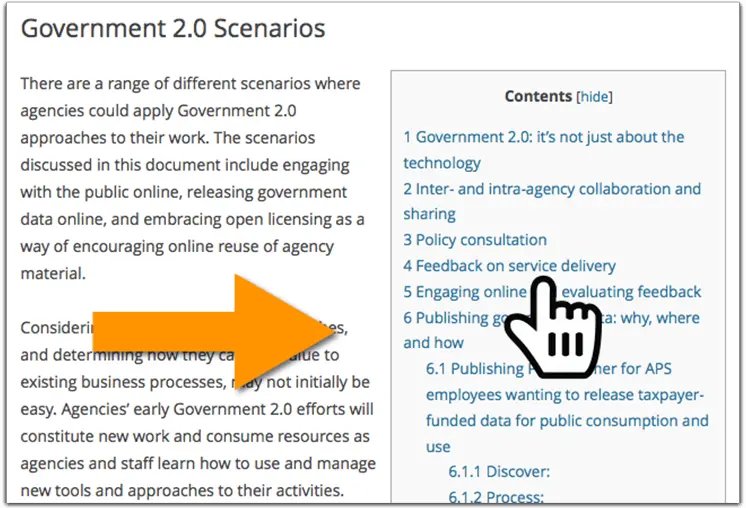 Use this plugin to generate a clickable table of contents for each of your articles.
Use this plugin to generate a clickable table of contents for each of your articles.
- I always make sure I use labels in my Google Spreadsheets to easier organize my article ideas
- I collect them all through a separate dashboard in Cyfe. You can iFrame as many Google Docs there as you want and have them all in front of your eyes whenever you are ready to work on your editorial calendar:
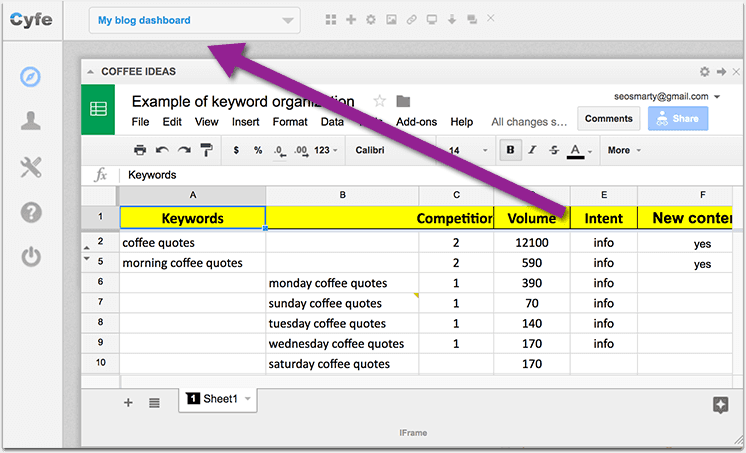
Where to Put Those Keywords?
This is another highly misunderstood area. It used to be as simple as making sure your keyword is placed often enough in the text and that every page of your site targets one specific keyword. A few years ago you would have been advised to create two separate pages, one target [Austin restaurants] and another targeting [restaurants in Austin]. Things have changed dramatically since then. For one, search engines have become much smarter and you cannot trick them into thinking your page is worth ranking simply because it has a high "keyword density". Besides, in-depth content covering many sets of different keywords is a preferred optimization model these days. So where to put those keywords?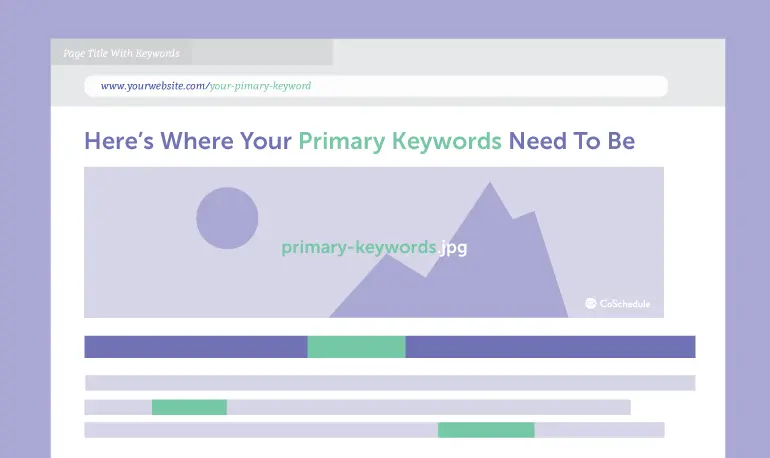 For good keyword prominence, I suggest making sure your keyword is included into:
For good keyword prominence, I suggest making sure your keyword is included into:
- Your article headline (And thus the page title). That's what Google usually picks as the clickable link in their search results too!
- Your URL slug
- First paragraph of the article
- Article subheadings

Going Beyond Keyword Strings: Synonyms, Entities, and Context
Google is going beyond exact strings of words that make up phrases. It is now looking for signals of quality content, mentions of known concepts, related terms, synonyms. All of these will tell Google that the author has done your research and tackle different aspects of the topic. That being said, keyword research is not enough to create high-quality high-ranking content. You need to research the topic, and then research some more, making the lists of notable brands, events, places, etc. (these are all entities) and thinking which of those should be covered in your content. Here's a good guide on content research process for your further reading.
Make sure you are well versed with industry terminology, that you know different ways to explain those niche-specific terms, that you use lots of synonyms and that your writing is rich in references and visual explanations. Those are all signals of high-quality content but not just that. The more effort you put into your content research, the more backlinks and social media shares it will generate, driving long-lasting traffic to your website.
You need to research the topic, and then research some more, making the lists of notable brands, events, places, etc. (these are all entities) and thinking which of those should be covered in your content. Here's a good guide on content research process for your further reading.
Make sure you are well versed with industry terminology, that you know different ways to explain those niche-specific terms, that you use lots of synonyms and that your writing is rich in references and visual explanations. Those are all signals of high-quality content but not just that. The more effort you put into your content research, the more backlinks and social media shares it will generate, driving long-lasting traffic to your website.
Do better #SEO keyword research with this guide from @seosmarty on the @CoScheduleBlog
Click To Tweet

